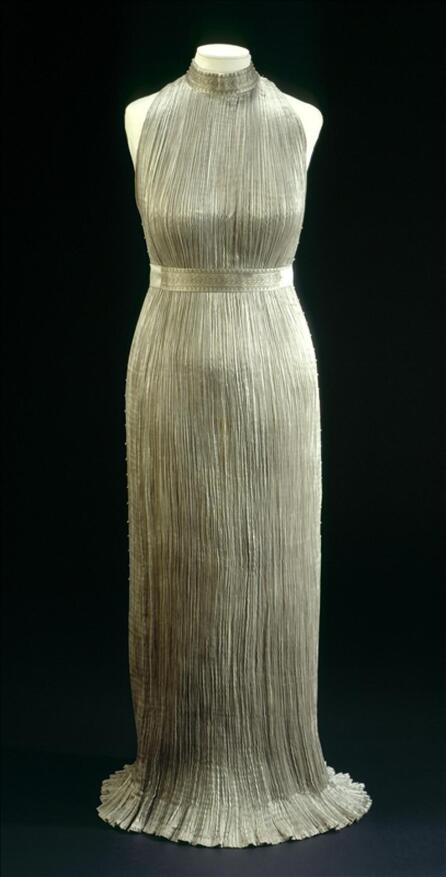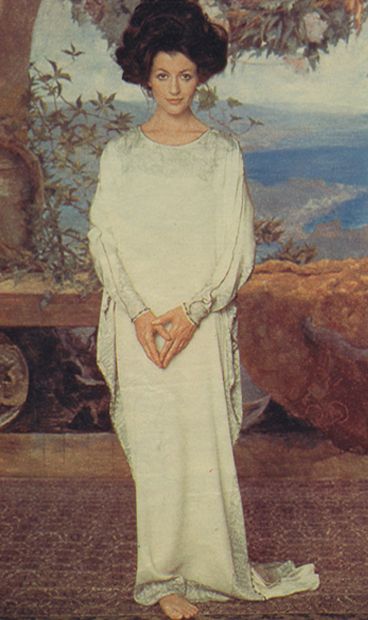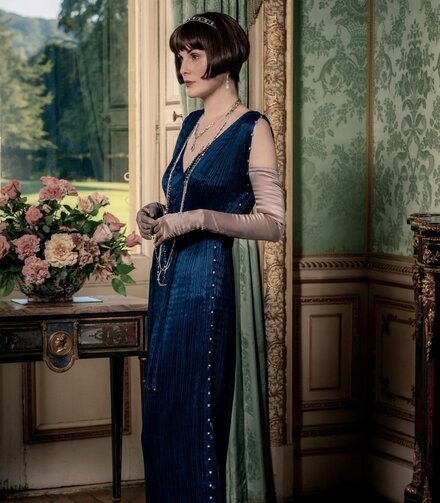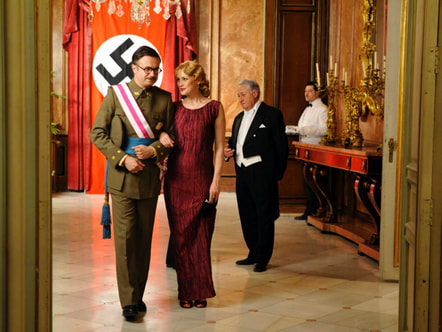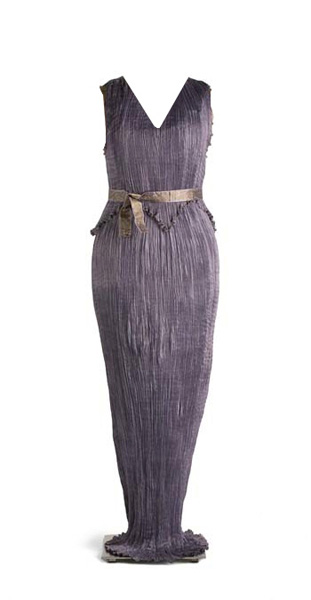|
The Delphos gown is a finely pleated silk dress first created in about 1907 by French designer Henriette Negrin (1877-1965) and her husband, Mariano Fortuny y Madrazo (1871–1949). They produced the gowns until about 1950. It was inspired by, and named after, a classical Greek statue, the Charioteer of Delphi. Since the 1970s, these gowns have been desirable and collectable pieces of vintage clothing, with one selling for a world record price of $10,000 in December 2001. The Delphos dress has been universally connected with Mariano Fortuny, while in fact it was a collective creative effort between him and his wife Henriette Negrin (1877-1965). It is thus fitting to remember this remarkable woman who has not been appreciated sufficiently by history, by remembering the Delphos dress, on her 144th birthday. Working out of a 13th-century Venetian palazzo, Fortuny, a Spanish-born artist turned textile designer, produced garments that the novelist Marcel Proust declared "faithfully antique but markedly original". The "Delphos" was a deliberate reference to the chiton of ancient Greece and meant to be worn without undergarments, since the chiton was itself a form of underwear, a radical suggestion during the early years of the 20th century. Fortuny became famous for his pleated dresses, the "Delphos" and the related "Peplos". The exact method of pleating was a closely guarded secret involving heat, pressure and ceramic rods, which has never been replicated. On both types of dresses, glass Murano beads are strung on a silk cord along each side seam. The beads serve a functional purpose as well as being decorative, as they weigh down the lightweight silk of the garment to ensure a smooth fit enhancing the natural, uncorseted human form beneath. The construction of the Delphos became its own decoration. It was originally intended as informal clothing or a tea gown for wearing solely in the privacy of the home, but eventually became formal wear, with Lauren Bacall wearing a vintage red Delphos to the 1978 Oscars. Delphos gowns were imported into Paris by the couturier Paul Poiret, and the fashion house Babani which sold them to actresses such as Eleonora Duse. Fortuny's garments, particularly the Delphos gown, have been valued for their artistic and aesthetic qualities since their creation. The fashion historian and writer Colin McDowell considers Fortuny one of the creators of fashion as art, and a Delphos gown was one of only two garments contained in the collection of the Museum of Modern Art, New York in 2003. During the 1910s and 1920s the Spanish painter Joaquín Sorolla painted several portraits of his wife and other sitters wearing Delphos gowns, some of which are preserved at the Museo Sorolla. The sculptor Hamo Thornycroft described his daughter Elfrida as looking lovely in a 'silk Greek clinging white dress', a Delphos which Elfrida later donated to the Victoria and Albert Museum. In literature, Marcel Proust described Fortuny's clothes several times in his epic novel In Search of Lost Time, comparing them to musical harmonies, although not explicitly calling them art. SpanishDelphos es una túnica femenina de fina confección, es plisada, larga, rectangular y ondulada elaborada en seda que cae de los hombros y cubre todo el cuerpo; está inspirada en la cultura griega clásica. El español Mariano Fortuny y Madrazo fue uno de los diseñadores de moda que se destacó por retomar en sus creaciones este tipo de indumentaria. La creación de este vestido tiene su origen en el interés de Mariano Fortuny por el arte griego, tras la visita que hizo a Grecia en 1906. En su residencia veneciana del palacio Orfei, él y Henriette Negrìn crearon un taller para estampar telas con el propósito de extraer diseños de antiguos fragmentos de textiles griegos. Mariano Fortuny patentó el Delphos el 10 de junio de 1909 y allí describió la manera de conseguir el plisado, apretando y retorciendo fuertemente con las manos bandas de tela mojada, hasta conseguir arrugarla a lo largo de la misma y seguidamente llevar a cabo ondulaciones horizontales. Esta técnica la lograba a través de una estructura que él mismo creó con tubos que actuaban en caliente. Los Delphos son iguales y piezas únicas, la diferencia está en la flexibilidad morfológica del modelo o la persona que lo va usar, ya que las mangas pueden ser cortas o largas y los escotes de diversa tipología. La comercialización de los primeros Delphos se inició en 1919. Para entonces, las creaciones de Fortuny ya llevaban su marca y logotipo. De esta manera su comercialización empezó a tomar auge, los Delphos eran enrollados en papel de seda en cajas pequeñas de cartón, diseñadas por el artista con su nombre escrito en la tapa.
En 1920 a partir de la primera tienda inaugurada en París, se podían adquirir en distinguidos almacenes en las más importantes ciudades europeas y norteamericanas. Fortuny tenía una amplia visión y proyección que le llevó a desarrollar una campaña publicitaria que tuvo impacto entre la alta sociedad. Él mismo se encargó de fotografiar su trabajo y contó con la colaboración de su esposa como modelo.
0 Comments
Leave a Reply. |
Archives
March 2024
Categories
All
|
